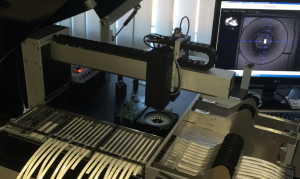 For years of our prototyping activities we have been looking for affordable solutions, which would improve the speed and quality of prototyping and assembly of proof-of-concept boards. Up till now, depending on the project type, we have either assembled the prototype boards on our own on a classical assembly station (preheater, hot air station and a tube of soldering paste), or had to send the project to our assembly partner. There are pros and cons of each of these paths and it is worth looking at them, when you consider improving your prototyping technology.
For years of our prototyping activities we have been looking for affordable solutions, which would improve the speed and quality of prototyping and assembly of proof-of-concept boards. Up till now, depending on the project type, we have either assembled the prototype boards on our own on a classical assembly station (preheater, hot air station and a tube of soldering paste), or had to send the project to our assembly partner. There are pros and cons of each of these paths and it is worth looking at them, when you consider improving your prototyping technology.
Classical manual PCB population on a simple station:
+ small tooling cost
+ full control over delivery time
+ no necessity of machine setup or stencil purchase
– management of component purchasing and storage
– lower assembly quality
– management of small quantities of components
– long assembly time
– execution of repeatable tasks
– no possibility of assembly of sophisticated projects
Third party automated PCB population:
+ high assembly quality (providing you have an experienced partner)
+ assembly of sophisticated projects
+ no or nearly none components’ management
– difficulty of finding a good prototyping partner
– problems with delivery time (prototypes are of low priority and get pushed back in the queue)
– high cost (machine population, stencils, third party cost)
– lack of specific project knowledge in the assembly company
Being a young company with insufficient funds to purchase our own machinery or let third party assemble the projects, we had to assemble prototypes fully on our own. The most annoying thing during that time, was applying soldering paste repeatedly on the same project and populating the PCBs with small components. The more sophisticated projects had been sent to our assembly partners. The cost was very high, but the quality was unmatchable. As we mainly work on fixed price basis, it was not easy to predict the exact cost and timing for several prototype series that had to be run during product design.
So for several years we have been looking for a solution, that would allow us to reduce the cost of a single prototype batch and keep strict control over the delivery process. The answer to PCB population problems is a new Pick and Place (P&P) machine from Mechatronic Systems GmbH. Although some of us (mainly me) have been skeptical about economical justification of such investment, we see an opportunity of accelerating prototype assembly and boosting its quality. We are also looking forward to purchasing a small oven, which will be our next investment.
The P&P machine is equipped with automated soldering paste dispensing head, automatic pick and place 4DOF robotic arm, automatic tape feeders, automatic nozzle changer, a camera for fiducial detection and component inspection and a bottom camera with LEDs for component orientation detection. We have already assembled several projects on it and I have to admit that the assembly quality is very good. It does require quite a bit of time spent for arming but with every project we are getting closer to an optimal solution. We will keep the most popular components in the automatic feeders and will still be thinking of best approach to non automated feeding to obtain superior performance.
The delivered software offers various assembly process tuning possibilities. The system is not ideal, but overall we are very happy with its performance. We hope it will perform very good over time. I guess the future will tell.
Summary – 5 reasons to upgrade your electronics prototyping station
We have made the right step towards prototype quality and delivery time improvement with a new pick and place machine. Although it requires quite a bit of operator’s time, we still think it will be a good investment and our clients will benefit from it.
The pros and cons of a desktop automatic pick and place machine are the following:
+ high prototyping quality (soldering paste application and component placement)
+ full control over delivery time
+ significant time savings when running the same project multiple times
+ no necessity of stencil ordering and storage
+ on-site assembly (with developers’ support) allows to use specific project knowledge
– time needs to be devoted to machine arming (that is what you pay for when you run the project with third party)
– operator needs to monitor the assembly process
Having improved our prototyping capabilities, we encourage you to submit your enquiry and let us handle your project.
